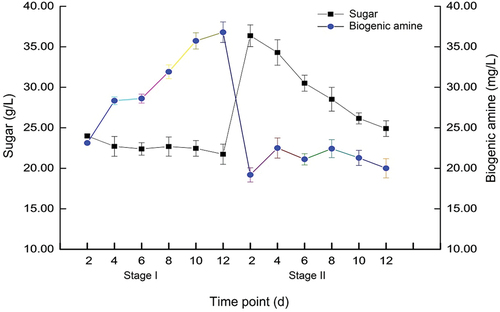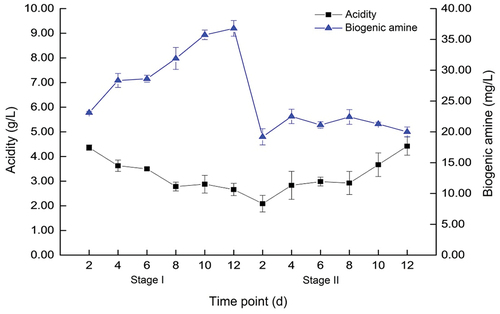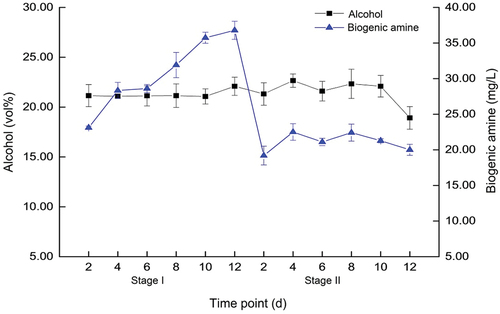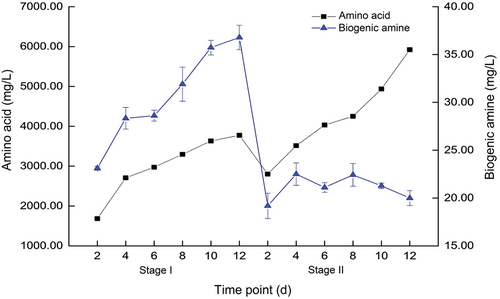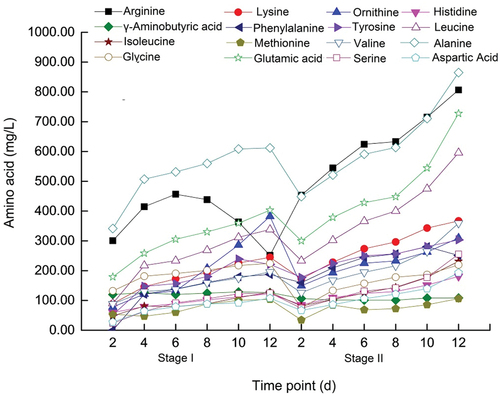ABSTRACT
Chinese rice wine (Huangjiu) is a traditional fermented wine in China. The biogenic amines are the important index during its fermentation. This study investigated the changes in biogenic amine content and its formation during fermentation of Chinese rice wine, and analyzed the correlation between the physicochemical and biological factors of Chinese rice wine and the production of biogenic amines. Results showed that, during the pre-fermentation stage (stage I), the content of biogenic amine was significantly negatively correlated with sugar level and acidity, and was significantly positively correlated with amino acid concentration. The maximum biogenic amine concentration in Chinese rice wine was 36.79 mg/L. During the post-fermentation stage (stage II), a significant increase in the content of lactic acid bacteria was positively correlated with biogenic amine content. The maximum biogenic amine concentration in Chinese rice wine was 22.50 mg/L. The high amino acid concentration and lactic acid bacteria concentration in the fermentation process enhance the biogenic amine formation. These results have provided a theoretical support for control of biogenic amine content in fermentation of Chinese rice wine.
Introduction
Fermented foods are the foods or beverages produced through controlled microbial growth, and the conversion of food components through enzymatic action.[Citation1] Biogenic amines belong to a class of low molecular weight compounds that contain amines and are commonly found in a variety of food items.[Citation2,Citation3] In particular, they are found in fermented food products, such as cheese, wine, fermented sausage, rice wine, and beer.[Citation4] Most naturally occurring biogenic amines are formed by the decarboxylation of free amino acids by amino acid decarboxylase, while others are formed via the amination of aldehydes and ketones.[Citation5] Excessive intake of biogenic amines triggers a variety of adverse reactions in the human body, such as nausea, headache, and palpitations, and these reactions could be life-threatening in serious cases.[Citation6] Amino acids are readily decarboxylated to form biogenic amines during fermentation, and the activity of monoamine oxidase is easily inhibited by alcohol and acetaldehyde, thus increasing the sensitivity of the human body to biogenic amines. Hence, the regulation of biogenic amines in fermented wine has been a popular research topic.[Citation7]
Chinese rice wine (Huangjiu) is a traditional fermented wine in China. It occupies an important position among the three major brewed wines (Chinese rice wine, grape wine and beer).[Citation8] The level of biogenic amines is an important index in the quality of Chinese rice wine.[Citation9] Zhang et al.[Citation10] have examined the biogenic amine content of the brewing raw material during Chinese rice wine fermentation and during the maturation and storage process. They find that the biogenic amine content in the seed starter exhibits a large variation range, which can influence the total content of biogenic amines prior to fermentation. A much more obvious increase in biogenic amines stems from the fermentation process, with the presence of a biogenic amine-producing bacteria and precursor amino amines. Liu et al.[Citation11] have found that the Lactobacillus may not produce biogenic amines in Chinese rice wine fermentation. They have developed three Lactobacillus strains without biogenic amines formation based on the next-generation sequencing technology. This study evaluated the changes in biogenic amines and the relationship between the quality indices of Chinese rice wine and biogenic amine formation during fermentation. It can provide an explanation of dynamic changes in biogenic amine levels during Chinese rice wine fermentation, as well as evidence for the regulation of biogenic amines in Chinese rice wine. The current study has significance for helping the manufacturers to find measures to control the biogenic amine production during Chinese rice wine fermentation, and improve the quality of Chinese rice wine products.
Materials and methods
Experimental materials
Yellow rice wine samples were obtained from Shaoxing Huangjiu Manufacturer (Shaoxing, China). Five biogenic amines (cadaverine, histamine, tyramine, spermidine, and spermine) were purchased from Sigma-Aldrich Inc. (MA, USA). Acetonitrile was purchased from Tedia Inc. (OSU, USA). Other reagents were of analytical grade, and were purchased from Sangon Biotech (Shanghai) Co., Ltd. (Shanghai, China).
Sample collection
Yellow rice wine samples were collected at pre-fermentation stage (stage I) and post-fermentation stage (stage II). For both fermentation stages, the sample was taken every 2 d, for a total of 12 d. Three repetitions were adopted for each sample taking.
HPLC quantification of biogenic amines
Biogenic amine quantification was carried out using HPLC method as described by Lu et al.[Citation12] The sample was derivatized with dansyl chloride. Gradient elution was performed with water and acetonitrile as the mobile phase at a flow rate of 0.8 mL/min. WondaCract ODS-2 C18 chromatography column (5 μm, 4.6 mm × 150 mm; Shimadzu Corp., Kyoto, Japan) was used. Biogenic amines in the sample were detected with UV light at 254 nm. A 10-μL aliquot of sample was injected. Standard solution mixtures of the five biogenic amines (cadaverine, histamine, tyramine, spermidine, spermine) were used to generate calibration curves and calculate the linear range of detection. The linear regression equations of the five amines were shown in .
Table 1. Regression equation, correlation coefficient, and detection limit of five biogenic amines.
Chemical indexes
Several of the chemical indices were determined via standard methods. Sugar level was determined according to the National Standard for Yellow Rice Wine (GB/T 13,662–2008).[Citation13] Alcohol content was determined according to the National Standard for Food Safety-Determination of Alcohol Concentration in Wine (GB/T 5009.225–2016).[Citation14] Amino acid concentration was determined according to the National Standard for Determination of Amino Acids in Foods (GB/T 5009.124–2016).[Citation15] The acidity was measured by acid-base titration. Ten milliliters of the wine sample were measured out and diluted to 50 mL. The diluted sample was titrated against 0.05 mol/L NaOH solution with phenolphthalein as the indicator. The volume of NaOH solution used was recorded when a light red color was observed and persisted for 30 s in the titration mixture. Finally, the acidity was calculated.
Lactic acid bacteria quantification
Lactic acid bacteria concentration was determined according to the National Standard for Microbiological Examination of Food: Lactic Acid Bacteria Determination (GB/T 4789.35–2016).[Citation16]
Statistical analysis
All statistical analysis was carried out using SPSS16.0 software (SPSS Inc., IL, USA). The correlation of continuous variables was investigated using Pearson correlation analysis. p < .05 and p < .01 were considered as statistically significant and highly statistically significant, respectively. The graphs were plotted using Origin 9.0 software (Origin Lab Inc., MA, USA).
Results and discussion
Change in biogenic amine concentration during Chinese rice wine fermentation
Change in biogenic amine concentration at stages I and II of fermentation (12 d each) of Chinese rice wine was investigated. The results were shown in . During stage I, the biogenic amine concentration in Chinese rice wine increased with fermentation time, and the maximum value was 36.79 mg/L. Tyramine was the predominant component (83.69% of the total biogenic amine content), followed by cadaverine (10.95%). Only a low level of histamine was detected, and no spermidine or spermine was found. During stage II, the biogenic amine concentration in Chinese rice wine increased firstly, and then decreased. The maximum value reached 22.50 mg/L. Tyramine was still the predominant component (70.5% of the total biogenic amine content), followed by cadaverine (17.5%). Similar to stage I, a low level of histamine was detected, and no spermidine or spermine was found. In Zhong et al.’s study, tyramine is the most prevalent amine in Chinese rice wine from the Shaoxing region.[Citation17] This is basically similar with the results of our study.
Table 2. Change in biogenic amines during fermentation.
Changes in chemical indices during biogenic amine formation
Relationship between sugar level and biogenic amine concentration
To understand the mechanism of biogenic amine formation, various chemical changes were investigated. The change in sugar level was first examined. As shown in , during stage I of fermentation, the sugar level decreases with fermentation time and is negatively correlated with biogenic amine concentration. The same trend was observed in stage II. Sugar degradation at this stage could prevent the proliferation of microorganisms. Thus, to maintain their vital activities, the microorganisms produced a high level of biogenic amines. A previous study[Citation18] has found that, the sugar concentration of the medium can influence decarboxylase activity; in particular, the lack of sugars has often been associated with higher biogenic amine production. This association can be explained by the fact that the decarboxylative pathway transport system provides metabolic energy. Results of our study can further confirm the findings in that study.
Relationship between acidity and biogenic amine concentration
Acidity is a very useful parameter for predicting the amino biogenic activity.[Citation19] Relationship between the change in acidity and biogenic amine concentration was shown in . In stage I, the acidity decreased with fermentation time and was negatively correlated to biogenic amine concentration. In stage II, the acidity increased and was negatively correlated with biogenic amine concentration. This indicates that, the high acidity can inhibit the formation of biogenic amines.
Relationship between alcohol content and biogenic amine concentration
In , the alcohol content increases slowly at first and then decreases slowly over the course of fermentation. In stage I, yeast activity promoted starch degradation and led to an increase in sugar level, acidity, and alcohol content, thus inhibiting the activity of lactic acid bacteria. In stage II, as lactic acid bacteria activity increased, sugar level decreased due to the decomposition and utilization of sugar, and acidity increased due to acid production. Alcohol content was stabilized. Over the course of fermentation, alcohol content was positively correlated to the formation of biogenic amines. In Aina et al.’s study,[Citation20] the biogenic amine level increases with the increase of alcoholic content during Sparkling wine fermentation. This is similar with the results of our study.
Relationship between amino acid concentration and biogenic amine concentration
Amino acids are the precursors of biogenic amines during fermentation. The amino acid concentration has major effect on the formation of biogenic amines.[Citation21] To further explore the influence of amino acid concentration change on the production of biogenic amines during fermentation, the change in the concentration of 16 amino acid species during biogenic amine formation was investigated. As shown in , amino acid concentration generally increased with fermentation time. During stage I, alanine reached a maximum concentration of 611.83 mg/L, followed by arginine (maximum concentration of 551.35 mg/L). During stage II, both alanine and arginine had the highest concentrations, reaching maximums of 864.82 mg/L and 806.45 mg/L, respectively. Additionally, amino acid concentration was positively correlated to biogenic amine formation.
As fermentation proceeds, amino acid concentration increases, facilitating their conversion to biogenic amines. Tyrosine, lysine, histidine, arginine, and methionine are the precursors of tyramine, cadaverine, histamine, spermidine, and spermine, respectively. As experimentally detected, the increase in tyramine, cadaverine, and histamine concentrations was as a result of the increase in their precursor amino acids. This demonstrates the direct effect of a high amino acid concentration on biogenic amine production.
Changes in lactic acid bacteria concentration during biogenic amine formation
Biogenic amines in fermented foods are mainly formed by the decarboxylation of amino acids in microorganisms. Lactic acid bacteria are found to play a major role in this process and have attracted much attention for this reason.[Citation22] To elucidate the formation mechanism of biogenic amines in Chinese rice wine, the change in lactic acid bacteria concentration during biogenic amine production was studied. The results were shown in . In stage I, lactic acid bacteria concentration decreased with fermentation time and was negatively correlated to biogenic amine concentration. In stage II, lactic acid bacteria concentration was positively correlated with biogenic amine concentration as fermentation proceeded. Stage I is dominated by yeast fermentation, which leads to an increase in the sugar level, acidity, and alcohol content, thus inhibiting lactic acid bacteria growth. To maintain its growth, the bacteria produce biogenic amines via stress-triggered metabolism.[Citation23] Following stage I, the starch and protein in the raw materials are degraded into nutrients and amino acids in stage II, the latter being the precursors of biogenic amines. These are used by lactic acid bacteria to promote their proliferation. This, in turn, facilitates the conversion of amino acids into biogenic amines.
Table 3. Change in lactic acid bacteria level during fermentation.
Correlation of sugar level, acidity, alcohol content, amino acid concentration with biogenic amine concentration
Sugar level, acidity, alcohol content, and amino acid concentration are the key chemical indices for evaluating the quality of rice wine, and their values change constantly during fermentation.[Citation24,Citation25] For this reason, correlation analysis was performed to determine the influence of various chemical factors on biogenic amine concentration during Chinese rice wine fermentation. The results were shown in . A significant negative correlation is observed between biogenic amine concentration and sugar level and acidity in fermentation stage I. A significant positive correlation is observed with amino acid concentration, but no significant correlation with alcohol content is found. In stage II, no significant correlation was observed between biogenic amine concentration and sugar level, acidity, alcohol content, or amino acid concentration. These results indicate stage I plays a greater role in biogenic amine production.
Table 4. Correlation of sugar level, acidity, alcohol content, and amino acid concentration with biological amine concentration during fermentation.
Lactic acid bacteria play an important role in the production of biogenic amines, with strain-specific activity.[Citation26] Considering the change in lactic acid bacteria, this is thought to be the key factor contributing to the increase in biogenic amine concentration in fermentation stage II. Hence, preferentially selecting lactic acid bacteria strains with low or no biogenic amine production could effectively control the content of biogenic amines in Chinese rice wine.
Conclusion
During the pre-fermentation stage, the content of biogenic amine in in Chinese rice wine was significantly negatively correlated with sugar level and acidity, and was significantly positively correlated with amino acid concentration. The maximum biogenic amine concentration in Chinese rice wine was 36.79 mg/L. During the post-fermentation stage, a significant increase in the content of lactic acid bacteria was positively correlated with biogenic amine content. The maximum biogenic amine concentration in Chinese rice wine was 22.50 mg/L. The high amino acid concentration and lactic acid bacteria concentration in the fermentation process enhance the biogenic amine formation. Hence, in pre-fermentation stage the effective control of biogenic amine concentration can be achieved by adjusting the content of amino acids during fermentation, with particular focus on tyrosine, lysine and histidine. In post-fermentation stage, the concentration of biogenic amines can be controlled by controlling the amount of lactic acid bacteria present or through the preferential selection of lactic acid bacteria strains. The findings of this study can help the manufacturers to find measures to control the biogenic amine production during Chinese rice wine fermentation, and improve the quality of Chinese rice wine products.
Disclosure statement
No potential conflict of interest was reported by the author(s).
Additional information
Funding
References
- Dimidi, E.; Cox, S. R.; Rossi, M.; Whelan, K. Fermented Foods: Definitions and Characteristics, Impact on the Gut Microbiota and Effects on Gastrointestinal Health and Disease. Nutrients. 2019, 11(8), 1806. DOI: 10.3390/nu11081806.
- Visciano, P.; Schirone, M. Update on Biogenic Amines in Fermented and Non-Fermented Beverages. Foods. 2022, 11(3), 353. DOI: 10.3390/foods11030353.
- Zhou, Q.; Jiang, L.; Zhu, J.; Lu, Y.; He, Q. The Metabolic Regulation Mechanism of Gallic Acid on Biogenic Amines and Nitrosamines in Reduced-Nitrite Chinese Fermented Sausages: A Perspective of Metabolomics and Metagenomics. Food Chem. 2024, 456, 139900. DOI: 10.1016/j.foodchem.2024.139900.
- Doeun, D.; Davaatseren, M.; Chung, M. S. Biogenic Amines in Foods. Food Sci. Biotech. 2017, 26(6), 1463–1474. DOI: 10.1007/s10068-017-0239-3.
- Ahmad, W.; Mohammed, G. I.; DA, A.-E.; Saigl, Z. M.; Alyoubi, A. O.; Alwael, H.; Bashammakh, A. S.; O’Sullivan, C. K.; El-Shahawi, M. S. Biogenic Amines Formation Mechanism and Determination Strategies: Future Challenges and Limitations. Crit. Rev. Anal. Chem. 2020, 50(6), 485–500. DOI: 10.1080/10408347.2019.1657793.
- Wójcik, W.; M, Ł.; Puppel, K. Biogenic Amines: Formation, Action and Toxicity-A Review. J. Sci. Food Agric. 2021, 101(7), 2634–2640. DOI: 10.1002/jsfa.10928.
- Restuccia, D.; Loizzo, M. R.; Spizzirri, U. G. Accumulation of Biogenic Amines in Wine: Role of Alcoholic and Malolactic Fermentation. Fermentation. 2018, 4(1), 6. DOI: 10.3390/fermentation4010006.
- Huang, Z. R.; Guo, W. L.; Zhou, W. B.; Li, L.; Xu, J. X.; Hong, J. L.; Liu, H. P.; Zeng, F.; Bai, W. D.; Liu, B., et al. Microbial Communities and Volatile Metabolites in Different Traditional Fermentation Starters Used for Hong Qu Glutinous Rice Wine. Food Res. Int. 2019, 121, 593–603. DOI: 10.1016/j.foodres.2018.12.024.
- Luo, Q.; Shi, R.; Gong, P.; Liu, Y.; Chen, W.; Wang, C. Biogenic Amines in Huangjiu (Chinese Rice Wine): Formation, Hazard, Detection, and Reduction. LWT-Food Sci. Technol. 2022, 168, 113952. DOI: 10.1016/j.lwt.2022.113952.
- Zhang, F.; Xue, J.; Wang, D.; Wang, Y.; Zou, H.; Zhu, B. Dynamic Changes of the Content of Biogenic Amines in Chinese Rice Wine During the Brewing Process. J. Inst. Brew. 2013, 119(4), 294–302. DOI: 10.1002/jib.93.
- Liu, S. P.; Yu, J. X.; Wei, X. L.; Ji, Z. W.; Zhou, Z. L.; Meng, X. Y.; Mao, J. Sequencing-Based Screening of Functional Microorganism to Decrease the Formation of Biogenic Amines in Chinese Rice Wine. Food Cont. 2016, 64, 98–104. DOI: 10.1016/j.foodcont.2015.12.013.
- Lu, Y. M.; Dong, M. S.; Lv, X.; Li, C. Biogenic Amines Contents in Rice Wine by HPLC. Food Sci. 2006, 27(1), 174–177. DOI: 10.3321/j.issn:1002-6630.2006.01.046. in Chinese.
- Potassium ferrocyanide titration method for determining the sugar level in yellow rice wine (chapter 6.2.2). National Standard for Yellow Rice Wine: GB/T 13662-2008. in Chinese.
- Alcohol meter method for determining the alcohol content in wine (chapters 7-11). National Standard for Food Safety-Determination of Alcohol Concentration in Wine: GB/T 5009.225-2023. in Chinese.
- Method for determining amino acids in foods using amino acid analyzer (chapters 1-8). National Standard for Determination of Amino Acids in Foods: GB/T 5009.124-2016. in Chinese.
- Method for determining lactic acid bacteria concentration in foods (chapters 1-7). National Standard for Microbiological Examination of Food: Lactic Acid Bacteria Determination: GB/TQ5 4789.35-2023. in Chinese.
- Zhong, J.; Ye, X.; Fang, Z.; Xie, G.; Liao, N.; Shu, J.; Liu, D. Determination of Biogenic Amines in Semi-Dry and Semi-Sweet Chinese Rice Wines from the Shaoxing Region. Food Control. 2012, 28(1), 151–156. DOI: 10.1016/j.foodcont.2012.05.011.
- Gardini, F.; Y, Ö.; Suzzi, G.; Tabanelli, G.; Özogul, F. Technological Factors Affecting Biogenic Amine Content in Foods: A Review. Front Microbiol. 2016, 7, 1218. DOI: 10.3389/fmicb.2016.01218.
- Cotter, P. D.; Hill, C. Surviving the Acid Test: Responses of Gram-Positive Bacteria to Low pH. Microbiol. Mol. Biol. Rev 2003, 67(3), 429–453. table of contents. DOI: 10.1128/MMBR.67.3.429-453.2003.
- Aina, M. C.; Anaïs, I. L.; Anaïs, I. L.; Javier, S. Oenological Processes and Product Qualities in the Elaboration of Sparkling Wines Determine the Biogenic Amine Content. Fermentation 2021, 7(3), 144. DOI: 10.3390/fermentation7030144.
- Izquierdo Cañas, P. M.; García Romero, E.; Gómez Alonso, S.; Fernández González, M.; Palop Herreros, M. L. L. Amino Acids and Biogenic Amines During Spontaneous Malolactic Fermentation in Tempranillo Red Wines. J. Food Compos. Anal. 2008, 21(8), 731–735. DOI: 10.1016/j.jfca.2007.11.002.
- González de Llano, D.; Cuesta, P.; Rodríguez, A. Biogenic Amine Production by Wild Lactococcal and Leuconostoc Strains. Lett. Appl. Microbiol 1998, 26(4), 270–274. DOI: 10.1046/j.1472-765x.1998.00320.x.
- Pessione, E.; Cirrincione, S. Bioactive Molecules Released in Food by Lactic Acid Bacteria: Encrypted Peptides and Biogenic Amines. Front Microbiol. 2016, 7, 876. DOI: 10.3389/fmicb.2016.00876.
- Xu, J.; Wu, H.; Wang, Z.; Zheng, F.; Lu, X.; Li, Z.; Ren, Q. Microbial Dynamics and Metabolite Changes in Chinese Rice Wine Fermentation from Sorghum with Different Tannin Content. Sci. Rep. 2018, 8(1), 4639. DOI: 10.1038/s41598-018-23013-1.
- Wang, Q. J.; Sun, D. W.; Jeong, S. T.; Yeo, S. H.; Choi, J. H.; Choi, H. S. Screening of Rice Cultivars for Brewing High Quality Turbid Rice Wine. LWT-Food Sci. Technol. 2014, 56(1), 145–152. DOI: 10.1016/j.lwt.2013.10.032.
- Barbieri, F.; Montanari, C.; Gardini, F.; Tabanelli, G. Biogenic Amine Production by Lactic Acid Bacteria: A Review. Foods. 2019, 8(1), 17. DOI: 10.3390/foods8010017.

